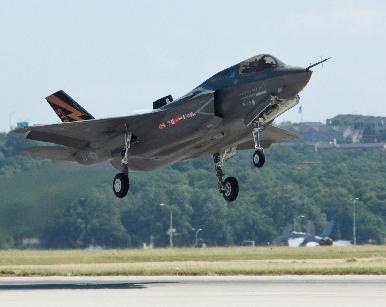This article is more than 1 year old
British pilot makes first supersonic stealth jumpjet flight
Harrier successor's engine bother hover hold-up
The world's first supersonic stealth jump-jet has made its debut flight, with a British test pilot at the controls. However, the F-35B "Lightning II" - intended to replace the famous Harrier in various armed forces including the RAF, Royal Navy and US Marines - isn't expected to show off its vertical-thrust abilities until next year.

Up still equals away, for now.
The first production F-35B, which came off the US production line last December, was taken up for its inaugural flight last week by BAE Systems test pilot Graham Tomlinson. Tomlinson formerly flew Harriers in the RAF, so he knows his jumpjets, but for now the F-35B is flying purely as a conventional aeroplane.
A statement from BAE quotes Tomlinson as saying that “a great team effort led to a relaxed first flight, with the aircraft handling and performing as predicted following earlier flights by the conventional variant of F-35 and many hours of simulator testing.”
The F-35 programme will produce three different variants of stealthy, supersonic attack plane. The A model, already flying, is built to operate from ordinary runways and will be bought by the US air force and various overseas customers. The C model will be designed to fly from fully equipped aircraft carriers with catapult launchers and arrester wires, and will be supplied to the US Navy.
The B model has a lift fan mounted in a central fuselage shaft, and can tilt its jet exhaust downwards. Like the Harrier, it won't be able to take off vertically with a full load of weapons and fuel, but it will be able to get airborne after only a short takeoff run - even shorter if a "ski-jump" ramp is used. Having flown a mission, burning fuel and possibly expending weaponry, it will be light enough to land vertically.
The F-35B will replace the Harriers currently flown by the RAF, Royal Navy and US Marines. It will be able to operate from US amphibious helicopter ships without catapults and arrester wires; and from the planned British fleet carriers which will also lack such kit.
“The STOVL [short take off and vertical landing] variant of the F-35 Lightning II is one of the most complex aircraft ever built," says BAE F-35 chief Mick Ord.
Despite its array of desirable features, the F-35B has its critics, especially as a solution for the British forces. Many have pointed out that the decision to go for jumpjet ships rather than proper carriers has denied the Royal Navy any chance to buy a proper fleet radar aircraft, and it's suggested that savings on cheaper carriers will be more than outweighed by the extra expense of vertical lift.
Apart from that, the F-35B will not offer the same performance as the A and C models in payload or range. There are even some concerns that it may not have enough thrust to land vertically while loaded with weapons. This would be a serious issue for the Royal Navy, which intends to use the plane as a carrier fighter; every time a jet landed after a routine patrol, it might have to dump expensive missiles into the sea beforehand. (This problem seriously affected the late, great Sea Harrier fighter in hot climates, which is why the Royal Navy now operates GR9 bomber Harriers.)
The RN is still hoping that the F-35B will be able to get back onto a ship without dumping weapons, however, using a so-called "ship-borne rolling vertical landing", so the issue of weight and thrust may not be a crippling one.
It'll be a while before anyone can really find out, though. Recent turbine blade failures during bench testing of engines have delayed the F-35 flight programme, and industry analysts reckon that serious vertical-thrust trials of the F-35B won't happen until well into next year. ®
